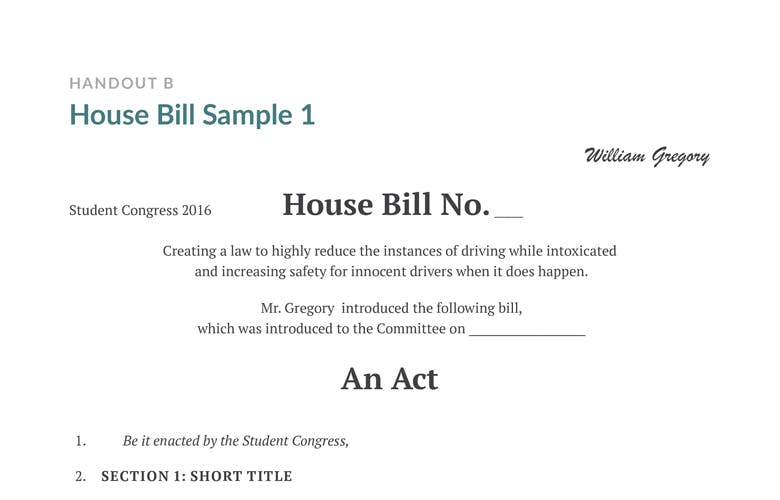Handout B: House Bill Sample 1
William Gregory
Student Congress 2016
House Bill No. _____
Creating a law to highly reduce the instances of driving while intoxicated
and increasing safety for innocent drivers when it does happen.
Mr. Gregory introduced the following bill,
which was introduced to the Committee on __________________________________
An Act
Be it enacted by the Student Congress,
- SECTION 1: SHORT TITLE
“This act may be cited as the New Mexico Zero Tolerance For Driving While 14 Intoxicated act” - SECTION 2: PURPOSE
The purpose for this law is to enforce laws concerning driving while intoxicated more strictly with greater consequences for its violations. This will lower the amount of deaths of both the
innocent and the violators and allow people to feel safer while on the road. - SECTION 3: DEFINITIONS
Breathalyzer – a device used to measure a person’s blood alcohol level. Blood Alcohol Level
– The amount of alcohol in your blood stream, recorded in milligrams of alcohol per 100 milliliters of blood. DWI – An acronym for driving while intoxicated. One way tire spike belts – A belt of spikes that allow cars to pass over them driving in one direction, but severely impair them if passed over in the wrong direction. - SECTION 4: MAIN PROVISIONS
This act will involve an almost full-scale attack on DWI. First, it will be a zero tolerance law. This means that there will be jail time for first-time offenders. Secondly, it will provide one way tire spikes on all off-ramps of interstate freeways in New Mexico to disallow drunk drivers to enter freeways going in the wrong direction causing danger to innocent drivers. It will also make people previously convicted of DWIs have to install breathalyzers in their cars that will have to be passed in order to make sure the driver has a legal blood alcohol level. - SECTION 5: APPROPRIATIONS
There will be a large start-up costs since there are about 200 exits off freeways in New Mexico with an off-ramp for each direction of the exit which makes about 400 total spike belts. With labor and materials needed for each spike belt costing $5,000, the total cost for start-up of the spike belt would be $2 million. Annual costs for repairing and replacing spike belts would be $400,000. The breathalyzers will not cost money because the person convicted of DWI would have to pay for it with their own money. There would however have to be jobs created to annually inspect the cars installed with breathalyzers that will have an annual costs of around $600,000. This is due to the fact that there will need to be 20 inspectors who will make $30,000 per year. This will be paid for by a 5% tax increase in alcoholic purchases for the first five years and a permanent 1% alcohol tax after that. Also 50% of the fine money collected will go towards annual costs. - SECTION 6: PENALTY CLAUSE
Anyone caught as a first-time offender will have to spend one week in jail, be fined $2,500, and lose their license for one year. They will also have to install breathalyzers in all of their cars that will have to be passed at a legal blood alcohol level for the car to start. Second-time offenders will spend one month in jail, be fined $5,000, will lose their license for two years, and their car will be auctioned off to pay for jail and processing fees. Third-time offenders will be charged with having an intent to kill and will spend no less than one year in jail and driving privileges will be revoked for five years. Tire spike damages will be at the cost of the driver of the vehicle whether they are drunk or not. Breathalyzers will be installed into cars at the cost of offenders. - SECTION 7: EFFECTIVE DATE
This act will go into effect on October 2, 2002. Construction for tire spike belts will begin on this date and will span over a two-year period. All other portions of this act will go into effect immediately.
